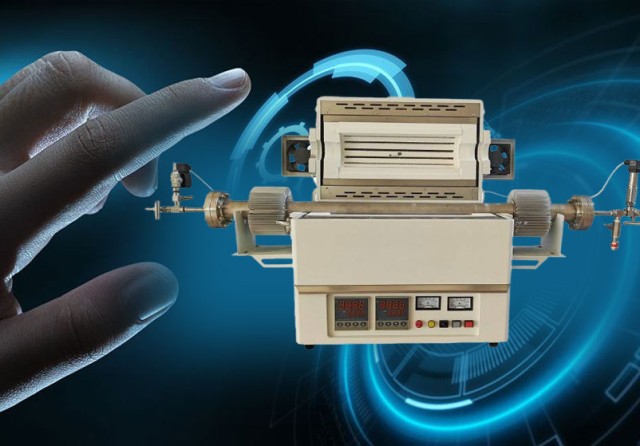Introduction to High Pressure Tube Furnaces
High pressure tube furnaces are pivotal in the realm of high-temperature and high-pressure scientific research and industrial applications. These specialized furnaces, characterized by their robust design and precise operational principles, play a crucial role in various fields including materials science, ceramics, and metallurgy. This guide delves into the intricacies of high pressure tube furnaces, exploring their fundamental components, diverse types, and extensive applications. By understanding the benefits and challenges associated with these furnaces, we can appreciate their significance in driving advancements in precise high-temperature processes.
Key Components of High Pressure Tube Furnaces
High pressure tube furnaces are essential tools in various scientific and industrial applications, particularly in materials science and ceramic processing. These furnaces are designed to operate under extreme conditions of high temperature and pressure, which require robust construction and precise control mechanisms. This section delves into the key components of high pressure tube furnaces, including the heating chamber, pressure control systems, and safety mechanisms, as well as the materials used in their construction.
Heating Chamber
The heating chamber is the core component of a high pressure tube furnace, designed to withstand and maintain high temperatures and pressures. It typically consists of a cylindrical cavity made from high-temperature ceramics, such as alumina or silicon carbide. These materials are chosen for their excellent thermal resistance and chemical stability, ensuring that the chamber can endure prolonged exposure to extreme conditions without degradation.
The heating elements, often embedded within the ceramic walls, are crucial for generating and maintaining the required temperature. These elements can be resistance wires, silicon carbide rods, or molybdenum disilicide heaters, which are capable of operating at temperatures exceeding 1800°C. The arrangement of these heaters is carefully designed to ensure uniform heat distribution within the chamber, which is essential for consistent processing of materials.
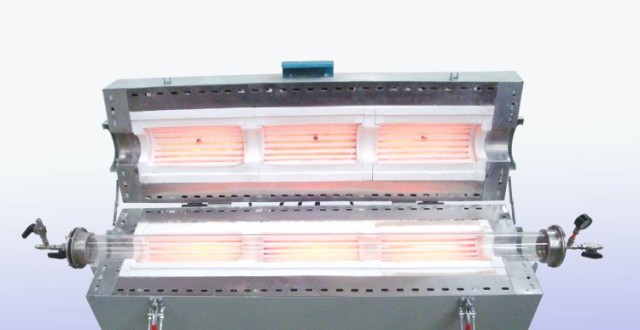
Pressure Control Systems
Controlling the pressure within the furnace is vital for many high-pressure applications, such as synthesis of advanced materials or high-pressure sintering. The pressure control system typically includes a pressure regulator, valves, and pressure gauges, which allow for precise adjustment and monitoring of the internal pressure. These components are often made from materials like stainless steel or hastelloy, which can withstand the corrosive and high-temperature environment inside the furnace.
Advanced pressure control systems may also incorporate automated mechanisms that allow for remote operation and real-time adjustments, enhancing the efficiency and safety of the process. For instance, some systems use computer-controlled valves that can respond to changes in temperature or pressure instantaneously, ensuring that the conditions within the furnace remain stable and within the desired parameters.
Safety Mechanisms
Given the hazardous nature of operating at high temperatures and pressures, safety mechanisms are critical components of high pressure tube furnaces. These mechanisms include pressure relief valves, which are designed to release excess pressure in the event of an overpressure situation, preventing potential explosions. Thermocouples and high-temperature alarms are also essential, providing continuous monitoring of the furnace temperature and alerting operators of any deviations from the set parameters.
Additionally, the furnace design often includes interlocks and emergency shutdown procedures that can be activated manually or automatically in case of an emergency. These safety features are crucial for protecting both the operators and the equipment, ensuring that the furnace can be safely operated even under extreme conditions.
Materials Used for Construction
The materials used in the construction of high pressure tube furnaces are selected based on their ability to withstand the harsh operating conditions. High-temperature ceramics, such as alumina and silicon carbide, are commonly used for the heating chamber due to their excellent thermal stability and resistance to chemical attack. Heating elements are typically made from high-purity alloys or refractory metals that can operate at elevated temperatures without significant degradation.
Pressure control components, such as valves and regulators, are often constructed from corrosion-resistant materials like stainless steel or hastelloy, which can handle the corrosive atmospheres and high temperatures inside the furnace. Insulation materials, such as ceramic fibers or refractory bricks, are used to minimize heat loss and protect the outer casing from high temperatures, ensuring that the furnace operates efficiently and safely.
In conclusion, the key components of high pressure tube furnaces, including the heating chamber, pressure control systems, and safety mechanisms, are meticulously designed and constructed to ensure reliable and safe operation under extreme conditions. The choice of materials and the precision of the control systems are critical for achieving consistent and high-quality results in various scientific and industrial applications.
Types of High Pressure Tube Furnaces
High pressure tube furnaces are essential tools in various scientific and industrial applications, offering precise temperature control and high-pressure environments for materials processing. These furnaces come in different types, each designed to meet specific needs and applications. The primary types include horizontal, vertical, and rotary high pressure tube furnaces, each with unique advantages and specialized applications.
Horizontal High Pressure Tube Furnaces
Horizontal high pressure tube furnaces are characterized by their horizontal orientation, where the tube is positioned parallel to the ground within the furnace chamber. This design is particularly suitable for applications requiring continuous processing of long samples or materials, such as heat-treating long wires or rods. Horizontal furnaces are known for their ability to reach high temperatures, often equipped with various heating elements such as resistance wires or graphite elements.
One of the key advantages of horizontal high pressure tube furnaces is their adaptability to different atmospheres, including inert, reducing, or vacuum conditions. This makes them ideal for precise processing, especially when dealing with small-diameter samples. The horizontal layout also facilitates easy sample insertion, typically through a combustion boat slid into the tube from one end. This feature ensures minimal disturbance to the sample during loading, enhancing the overall precision and consistency of the process.
Vertical High Pressure Tube Furnaces
Vertical high pressure tube furnaces, on the other hand, have a vertical orientation, with the tube positioned vertically within the furnace chamber. This design is particularly advantageous for applications requiring uniform heating of a sample or material, such as calcination or sintering of powders. The vertical orientation ensures that the heat is evenly distributed throughout the sample, leading to consistent results and minimal thermal gradients.
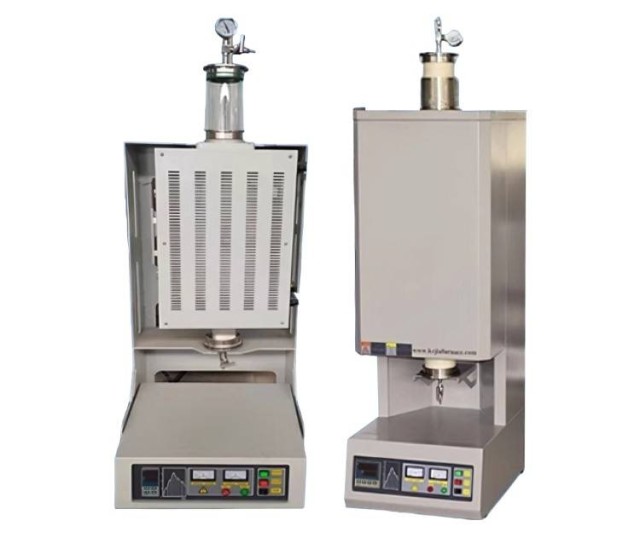
Vertical furnaces can also reach high temperatures and are equipped with various heating elements, such as molybdenum disilicide elements or ceramic fiber elements. The vertical design allows for easy loading and unloading of samples, as the material can be placed directly into the tube without the need for complex handling mechanisms. This simplicity in operation makes vertical high pressure tube furnaces a popular choice in laboratories and industrial settings where ease of use and reliability are paramount.
Rotary High Pressure Tube Furnaces
Rotary high pressure tube furnaces are designed for continuous processing of materials or samples by rotating them within a cylindrical chamber that is heated by a heating element. The rotary motion ensures uniform heating of the sample or material, facilitating efficient mixing and blending. This design is particularly useful for applications requiring high-temperature processing of powders or granules, such as calcination or roasting.
The rotary motion in these furnaces not only ensures uniform heating but also helps in maintaining a consistent pressure environment within the tube. This is crucial for processes where maintaining a specific pressure is essential for the desired outcome. Rotary high pressure tube furnaces can be equipped with various heating elements, such as ceramic fiber elements or silicon carbide (SiC) elements, providing flexibility in temperature control and processing capabilities.
Comparative Advantages
Each type of high pressure tube furnace offers distinct advantages based on the specific application requirements. Horizontal furnaces provide precision and adaptability to different atmospheres, making them suitable for delicate processes involving small samples. Vertical furnaces offer uniform heating and ease of operation, ideal for applications requiring consistent thermal treatment of powders or similar materials. Rotary furnaces, with their continuous processing and uniform heating capabilities, are particularly advantageous for high-temperature processes involving powders or granules.
In conclusion, the choice of high pressure tube furnace depends on the specific needs of the application, including the type of material being processed, the required temperature range, and the desired processing atmosphere. Understanding the unique features and advantages of each type can help in selecting the most appropriate furnace for a given task, ensuring optimal performance and results.
Applications of High Pressure Tube Furnaces
High pressure tube furnaces are indispensable tools in various industries and research fields, offering precise temperature control and versatile operational capabilities. These furnaces are particularly renowned for their applications in materials science, ceramics, metallurgy, and advanced manufacturing processes. Below, we delve into the specific uses and benefits of high pressure tube furnaces across these sectors.
Materials Science
In materials science, high pressure tube furnaces are crucial for synthesizing and testing new materials under controlled conditions. These furnaces allow researchers to simulate extreme environmental conditions, which is essential for developing advanced materials with tailored properties. For instance, the ability to control temperature gradients and pressure within the furnace facilitates the creation of complex alloys and composites with enhanced strength and durability. Additionally, these furnaces are used in the study of phase transformations and microstructural evolution of materials under high pressures and temperatures, providing insights into material behavior that can be applied in various industrial processes.
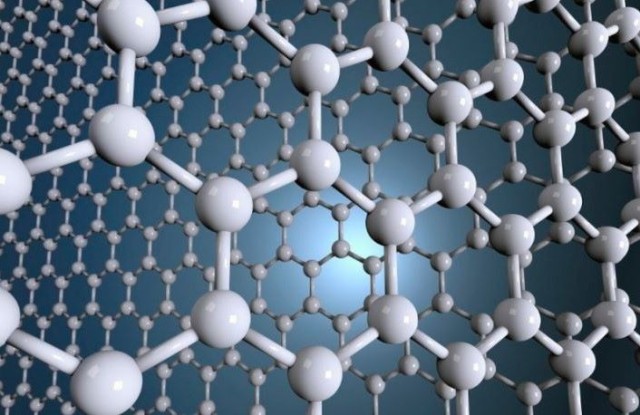
Ceramics Industry
The ceramics industry extensively utilizes high pressure tube furnaces for the production of high-performance ceramics. These furnaces enable the sintering of ceramic powders at high temperatures and pressures, resulting in dense and strong ceramic materials. Applications range from the manufacturing of ceramic tiles and pottery to the production of advanced ceramics used in aerospace and electronics. The precise temperature control and uniform heating provided by these furnaces ensure the quality and consistency of the final ceramic products.
Metallurgy
In metallurgy, high pressure tube furnaces play a pivotal role in various processes such as annealing, brazing, and heat treatment. These furnaces are capable of reaching temperatures up to 1800°C, making them suitable for melting and refining metals. The high pressure environment within these furnaces can also enhance the diffusion of elements in alloys, leading to improved homogeneity and mechanical properties. Moreover, these furnaces are used in the production of specialty metals and alloys that require specific heat treatment under controlled atmospheres.
Advanced Manufacturing Processes
High pressure tube furnaces are also integral to advanced manufacturing processes, including the production of semiconductors, batteries, and polymer composites. In the semiconductor industry, these furnaces are used for the deposition of thin films and the growth of semiconductor crystals under high pressures and temperatures. Similarly, in the battery manufacturing sector, these furnaces are employed for the synthesis of battery materials and the formation of battery electrodes. The ability to maintain high pressures and temperatures ensures the quality and performance of these critical components.
Research and Development
Beyond industrial applications, high pressure tube furnaces are essential in research and development across various domains. They are used in laboratory settings for materials testing, crystal growth, and the study of high-pressure physics. The versatility and precision of these furnaces make them ideal for conducting fundamental research that can lead to breakthroughs in materials science and technology.
In conclusion, high pressure tube furnaces are versatile and powerful tools that find extensive applications in materials science, ceramics, metallurgy, and advanced manufacturing processes. Their ability to provide controlled high-pressure and high-temperature environments makes them indispensable for developing and testing new materials and technologies. As industries continue to push the boundaries of what is possible, the role of high pressure tube furnaces will only become more critical.
Benefits of Using High Pressure Tube Furnaces
High pressure tube furnaces are integral to advanced materials processing and research, offering a range of benefits that enhance experimental control, product quality, and versatility. These furnaces are equipped with features such as tube plugs, thermal fixtures, and multiple tube diameter options, which significantly improve their performance and efficiency.
Enhanced Process Control
One of the primary advantages of high pressure tube furnaces is their ability to provide enhanced process control. The incorporation of tube plugs and thermal fixtures allows for precise management of temperature gradients within the furnace. This strategic placement of fixtures ensures a more uniform heat distribution, which is critical for applications that require consistent and controlled thermal conditions. By minimizing temperature variations along the length of the tube, these furnaces ensure greater stability and consistency in heat treatment processes. This level of control is particularly beneficial in materials processing, where even slight temperature variations can significantly impact the final properties of the materials being processed.
Improved Product Quality
The improved control over temperature gradients directly translates to better product quality. In industries such as ceramics, metallurgy, and advanced materials research, the ability to maintain precise temperature conditions is essential. High pressure tube furnaces facilitate the production of high-quality, consistent products by ensuring that each batch undergoes the same thermal treatment. This consistency is crucial for maintaining the integrity and performance of the final product, whether it's a ceramic component, a metal alloy, or a sophisticated composite material.
Versatility in Handling Different Materials and Processes
High pressure tube furnaces are designed to be versatile, accommodating a wide range of materials and processes. The option for multiple tube diameters allows for the processing of different sample sizes and types within a single furnace setup. This versatility is particularly useful in research environments where various experiments require different configurations. Additionally, the ability to operate under high pressure conditions opens up new possibilities for material synthesis and processing, enabling the creation of materials with unique properties that would not be achievable under standard atmospheric conditions.

Optimized Heating Efficiency
By controlling heat distribution more precisely, high pressure tube furnaces contribute to improved heating efficiency. This not only saves energy but also enhances the overall performance of the furnace. Efficient heating is essential for reducing operational costs and minimizing environmental impact. The advanced computer controls integrated into modern high pressure tube furnaces further optimize heating efficiency by continuously monitoring and adjusting the furnace's operating parameters.
Safety and Regulatory Compliance
High pressure tube furnaces are designed with safety and regulatory compliance in mind. The pressure vessel designs have evolved to meet and exceed regulatory standards, ensuring increased cycle life, higher pressure processing capabilities, and enhanced safety. New furnace designs and materials, such as molybdenum, steel, and graphite, are selected based on the specific process requirements and needs, ensuring that the furnace operates within safe temperature parameters and maintains cleanliness where necessary.
Conclusion
In summary, high pressure tube furnaces offer a multitude of benefits that make them indispensable in both research and industrial applications. Their ability to provide enhanced process control, improve product quality, and handle a wide range of materials and processes makes them a versatile and efficient choice. Additionally, their optimized heating efficiency and commitment to safety and regulatory compliance ensure that they are not only effective but also reliable and sustainable. As technology continues to advance, high pressure tube furnaces will remain at the forefront of materials science and industrial production, unlocking new possibilities and driving innovation in various fields.
Challenges and Considerations
High pressure tube furnaces are essential tools in various scientific and industrial applications, particularly for processes requiring high temperatures and controlled atmospheres. However, their operation comes with several challenges and considerations that must be addressed to ensure safety, efficiency, and longevity. This section delves into the primary issues associated with high pressure tube furnaces, including maintenance, safety concerns, and operational costs, and provides insights into best practices and solutions to common problems.
Maintenance Challenges
Maintenance of high pressure tube furnaces is crucial to prevent downtime and ensure consistent performance. Key maintenance tasks include:
-
Regular Cleaning: The furnace chamber and tubes must be cleaned regularly to remove any residues or deposits that could affect thermal conductivity or react with the atmosphere inside the furnace. This is typically done using appropriate solvents or mechanical methods, ensuring that no damage is caused to the heating elements or the tube material.
-
Component Replacement: Heating elements, thermocouples, and seals are critical components that degrade over time due to continuous exposure to high temperatures and corrosive atmospheres. Regular inspection and timely replacement of these components are essential to maintain the furnace's operational integrity.
-
Gas System Maintenance: The gas supply system, including valves, pressure regulators, and flow meters, must be checked regularly for leaks, blockages, and accuracy. Ensuring the correct flow and pressure of protective or reactive gases is crucial for both the quality of the process and the safety of the operation.
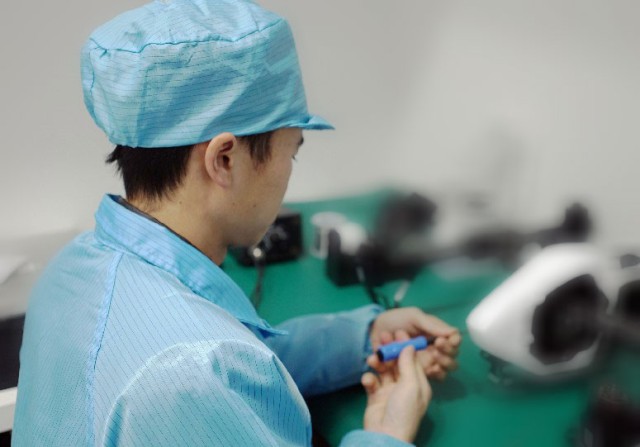
Safety Concerns
Safety is paramount when operating high pressure tube furnaces. These furnaces can reach temperatures exceeding 1500°C and operate under high pressures, posing significant risks if not managed properly. Key safety considerations include:
-
Personal Protective Equipment (PPE): Operators must wear appropriate PPE, including heat-resistant gloves, face shields, and fire-resistant clothing, to protect against burns and exposure to harmful gases.
-
Emergency Procedures: Clear and well-practiced emergency procedures are essential. This includes procedures for shutting down the furnace in case of a malfunction, handling gas leaks, and responding to fires.
-
Ventilation and Isolation: The furnace area should be well-ventilated to prevent the buildup of toxic or flammable gases. Additionally, the furnace should be isolated from other equipment to prevent accidental contact or interference during operation.
Operational Costs
Operational costs for high pressure tube furnaces can be significant, primarily due to energy consumption and the need for regular maintenance and replacement of components. Strategies to manage these costs include:
-
Energy Efficiency: Optimizing the furnace settings to minimize energy use without compromising process quality can significantly reduce operational costs. This might involve adjusting heating profiles, insulation, and cooling procedures.
-
Preventive Maintenance: By scheduling regular maintenance checks and adhering to a strict maintenance schedule, potential issues can be identified and resolved before they escalate, reducing the likelihood of costly breakdowns or safety incidents.
-
Component Lifecycle Management: Understanding the lifecycle of key components and planning for their replacement can help manage costs and ensure that the furnace operates efficiently throughout its service life.
Best Practices and Solutions
To address these challenges, several best practices and solutions can be implemented:
-
Training and Education: Regular training for operators on the safe and efficient operation of high pressure tube furnaces is essential. This includes understanding the equipment, recognizing potential hazards, and knowing how to respond to emergencies.
-
Advanced Monitoring Systems: Implementing advanced monitoring systems that track temperature, pressure, and gas flow in real-time can help identify issues early and optimize performance.
-
Quality Control: Ensuring that all components and materials used in the furnace are of high quality can reduce the frequency of replacements and extend the overall lifespan of the furnace.
In conclusion, while high pressure tube furnaces present several operational challenges, these can be effectively managed through careful maintenance, adherence to safety protocols, and strategic cost management. By implementing best practices and leveraging advanced technologies, these furnaces can continue to be invaluable tools in high-temperature processing applications across various industries.
Future Trends in High Pressure Tube Furnaces
High pressure tube furnaces are pivotal in various scientific and industrial applications, particularly in materials science, semiconductor production, and advanced manufacturing processes. As technology evolves, these furnaces are undergoing significant transformations to meet the escalating demands for precision, efficiency, and safety. This section delves into the emerging trends and technological advancements in the design and application of high pressure tube furnaces, exploring their potential impact on future research and industrial processes.
Advancements in Furnace Design and Materials
The design of high pressure tube furnaces is becoming increasingly sophisticated, with a focus on enhancing performance and versatility. Incorporating features such as tube plugs, thermal fixtures, and multiple tube diameters allows for better control over temperature gradients and improved uniformity in heat distribution. These enhancements are crucial for accommodating diverse experimental requirements and ensuring consistent results across different tube sizes within a single furnace setup.
Material selection is another critical aspect of furnace design. Traditional materials like molybdenum, steel, and graphite are being supplemented or replaced by advanced materials that offer better thermal conductivity, higher resistance to corrosion, and improved durability. For instance, the use of molybdenum in furnace construction provides excellent high-temperature performance, while graphite offers a balance between thermal efficiency and cost-effectiveness. These materials are selected based on specific process requirements, such as maximum temperature, cleanliness, and overall economy.
Integration of Advanced Control Systems
The integration of advanced computer control systems is revolutionizing the operation of high pressure tube furnaces. These systems monitor and control various parameters in real-time, ensuring optimal performance and safety. Advanced controls allow for precise temperature management, pressure regulation, and automated process adjustments, which are essential for maintaining consistency and efficiency in high-pressure environments.
Moreover, these control systems can be networked to manage multiple furnaces within a plant, enabling centralized monitoring and control. This capability is particularly beneficial for large-scale industrial operations that require coordinated management of multiple heating processes. The use of predictive analytics and machine learning algorithms in these control systems is also on the rise, promising even greater precision and efficiency in the future.

Enhanced Safety and Regulatory Compliance
Safety remains a paramount concern in the design and operation of high pressure tube furnaces. Recent advancements in pressure vessel designs have focused on increasing cycle life, higher pressure processing capabilities, and enhanced safety features. These improvements are driven by evolving regulatory standards and the need to ensure the integrity of high-pressure environments.
New furnace designs incorporate advanced safety mechanisms, such as pressure relief valves, temperature sensors, and automated shutdown procedures, to prevent accidents and protect both personnel and equipment. Additionally, these furnaces are designed to meet stringent regulatory requirements, ensuring compliance with industry standards and reducing the risk of operational failures.
Applications in Emerging Industries
The versatility and performance of high pressure tube furnaces are opening new avenues in emerging industries. For example, in the field of additive manufacturing, these furnaces are used for sintering and debinding processes, enabling the production of complex and high-strength components. In the battery production industry, high pressure tube furnaces are employed for the synthesis of advanced battery materials, such as lithium-ion and solid-state batteries, which require precise thermal processing.
In the realm of advanced ceramics and nano-materials, these furnaces play a crucial role in synthesizing materials with unique properties. The ability to control temperature and pressure with high precision allows for the creation of materials with tailored characteristics, such as high strength, thermal resistance, and electrical conductivity.
Conclusion
The future of high pressure tube furnaces is marked by continuous innovation and advancement. Enhanced design, advanced control systems, improved safety features, and expanded applications are reshaping the landscape of materials science, research, and industrial production. As these furnaces become more sophisticated and efficient, they will continue to drive breakthroughs in various industries, paving the way for new possibilities in materials and process development. The relentless pursuit of innovation in high pressure tube furnaces ensures that they remain indispensable tools in the quest for technological advancement and industrial excellence.
Conclusion
In conclusion, high pressure tube furnaces stand as pivotal tools in both scientific research and industrial applications, enabling precise high-temperature and high-pressure processes. From their robust design and diverse types to their wide-ranging applications and significant benefits, these furnaces play a crucial role in sectors such as materials science, ceramics, and metallurgy. While challenges such as maintenance and safety persist, ongoing technological advancements promise enhanced capabilities and efficiencies. As we look to the future, high pressure tube furnaces will continue to be instrumental in pushing the boundaries of high-temperature and high-pressure processes, driving innovation and quality in modern science and industry.
Related Products
- High Pressure Laboratory Vacuum Tube Furnace Quartz Tubular Furnace
- 1700℃ Laboratory High Temperature Tube Furnace with Alumina Tube
- 1400℃ Laboratory High Temperature Tube Furnace with Alumina Tube
- Vertical Laboratory Tube Furnace
- Vacuum Hot Press Furnace Heated Vacuum Press Machine Tube Furnace
Related Articles
- The Breakthrough in a Box: How Vacuum Tube Furnaces Eliminate Contamination in Materials Research
- High Pressure Tube Furnace: Applications, Safety, and Maintenance
- The Silent Partner in Pyrolysis: Engineering the Perfect Thermal Boundary
- Introducing the Lab Vacuum Tube Furnaces
- Exploring the Key Characteristics of Tube Heating Furnaces
